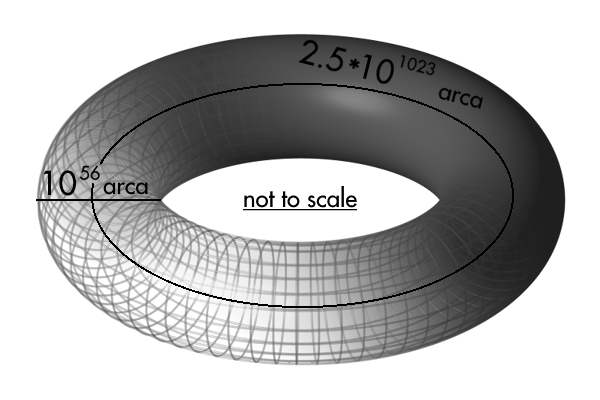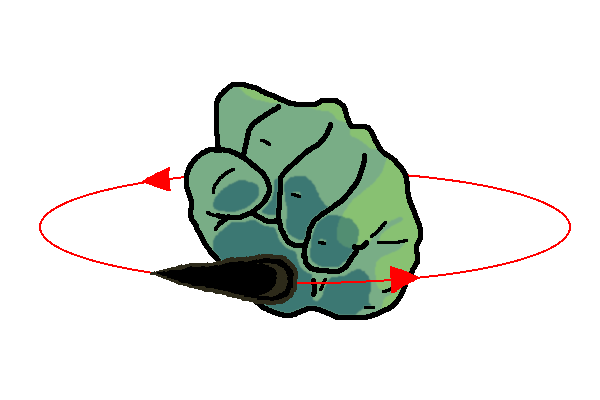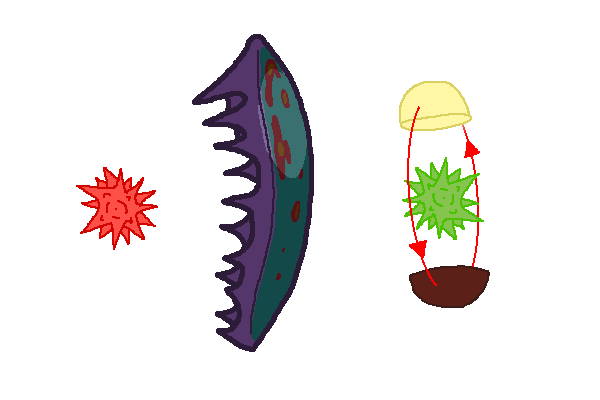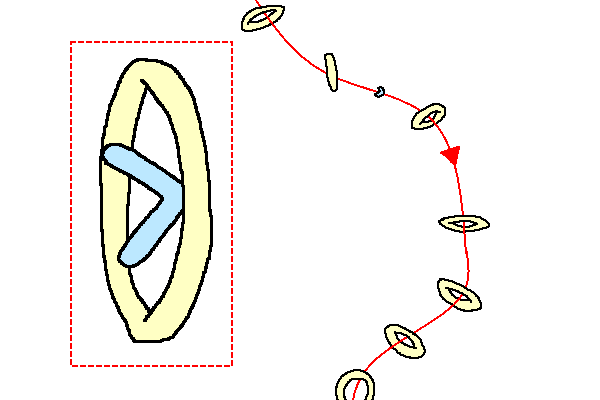Sarcinia itself kind of takes the form of a toroid, but for most relevant intents and purposes it is much better defined as a cylinder that loops upon itself from both ends. the diameter of the cylinder is approximately 1e56 arcas across, and the 'height' of the cylinder before it loops is 2.5e1023 arcas. It is important to remember that there is no default orientation for the universe, so don't think of this height as up and down. This incredible size makes the shape of the universe mostly irrelevant.

The volume of the universe I have calculated to be 2.0e1135 arca, and an arca is about 0.000008 nm3, so that gets to about 1.6e1093 km3. Our universe is 6.6e9 km3. Maybe sarcinia is huge.
Constructs are cumulations of arcana to form matter, most of the time due to connecting molecules. Constructs can be as little as a 10-arcana line or as large as a crystalline monolith of 10^150 of arcana. Think of these like matter in our universe.
The main important types of large constructs, or celestial bodies, are Attric, Lumic, Antilumic, Thermic, Antithermic, and Terric. Large constructs often take up one or multiple of these types. Unlike our world where most large entities are spherical due to gravity, here such limitation is not necessary. Systematic conjunctions of all of these types lead to many different configurations of orbits, entities, and space.
Attric celestials primarily attract and compel other constructs towards it, like a gravitational source. The amount of force compelling does not correlate directly with mass, but more likely than not a higher mass Attric construct will attract harder towards it. It's important to understand that most large constructs have some semblance of attraction, because if they didn't they wouldn't be able to form. Attrics specifically has the ability to compel their forces across great distances and produce orbits. Attric entities may also not uniformly attract things towards the centre of the entity, it can attract in only a specific direction, specific place, or other phenomena.
Lumic celestials emit light. It can be a soft glow or a blinding flare. These lumic entities can fluctuate their light, pulsating their glow across intervals sinusoidally. A small amplitude in fluctuation make the lumic essentially constant. A large amplitude across a large interval could appear as the entity glowing blazingly for a thousand years, and returning to a faint shimmer for the next thousand years. Similarly, Antilumic (or Umbric) celestials omit light, or rather emit darkness. A lumic construct and umbric construct may cancel each other out. Not even accounting for the movement of these entities, this can cause light cycles to be more complicated than a consistent rising and setting sun, but with enough mathematics still remain a predictable constant.
Thermic, or Potic celestials emit heat, or high amount of pota. In special cases they even emit spirit! A spherical entity that is both Thermic and Lumic could mimic the stars of our universe. Antithermic entities, or Frigic, do the opposite and remove heat.
Terric celestials are the closest thing to terrestrial planets. Their molecules are much more physical, and can be solid like rock or liquid like water. Most life will live on terric large constructs, but life can also thrive elsewise.

Here an attric, terric, (AT) coincidentally fist-shaped rocky celestial is illuminated off screen by a lumic (L) celestial, providing light on the right. The umbric (U) conical celestial orbits around the attric, emitting its darkness on the attric. The umbric's dark is stronger than the lumic's light, so when their effects intersect it is still darker.

This terric (T) world is sort of flat, situated between the pulls of two spiky-looking attric (A) celestials. The right attric also hosts congruent orbits of 2 hemispherical celestials, one is lumic (L) and the other is thermic (P). For people that live on the convex side of this terric perhaps they associate the 'day' with coldness and the 'night' with warmth.

This configuration is quite fantastical. A collection of attric ring-shaped celestials all orient their gravity in a specific direction, pulling things inwards and pushing them through their holes. One of these things is a lumic frigic (LF) boomerang-shaped celestial taking its course throughout the attric track. Some very novel types of life may find their way to prosper here somehow, floating within the boomerang...
If you have any other creative ideas for celestial configurations do let me know! I don't think anyone that already can't contact me is looking at this website anyways so... you know how to contact.